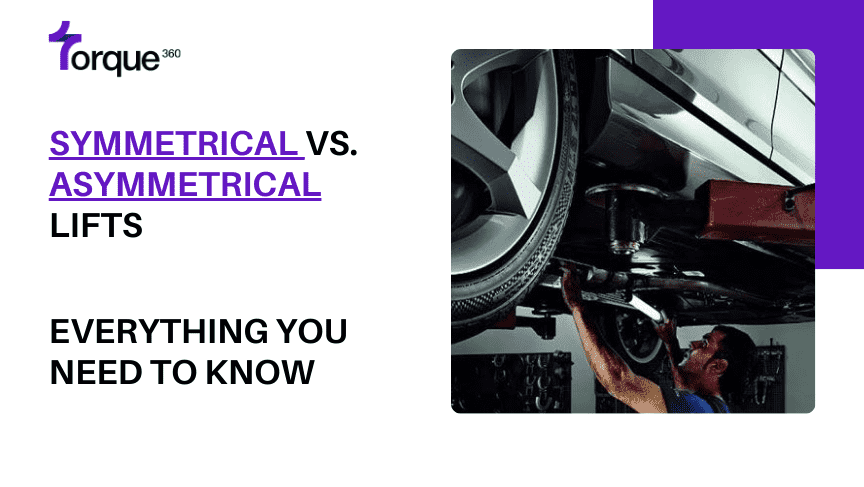Are you considering a new 2-post car lift but are still determining whether a symmetrical or asymmetrical garage model suits your needs?
Choosing the right car lift is crucial for any automotive shop, making it one of the most significant investments.
Although symmetrical car lifts are general, asymmetrical lifts present several advantages.
When deciding between symmetrical Vs. asymmetrical lifts, several essential factors deserve consideration.
This blog post will explore asymmetrical and symmetrical lifts’ distinct features, advantages, and drawbacks. Let’s dive in!
Explore 2-post Car Lift.
Starting your research with two-post car lifts is a wise choice. These lifts are a staple in nearly every auto repair facility, especially drive-in auto shops. They use four adjustable arms to elevate heavier vehicles, providing technicians with easy access for maintenance.
Versatility and Functionality:
The versatility of two-post lifts significantly contributes to their appeal. Their design allows technicians to efficiently conduct various maintenance tasks underneath vehicles, including engine and gearbox work, owing to their impressive lifting capacity.
Ideal for Limited Ceiling Space:
Two-post lifts emerge as one of the top choices for auto repair shops with lower ceiling heights. They accommodate light trucks, vans, and standard vehicle sizes, boasting lifting capacities of up to 20,000 pounds (depending on the specific lift model).
Ground Attachment for Enhanced Durability:
During installation, two-post lifts firmly attach to the ground. This attachment provides stability and enhances durability, ensuring longevity for prolonged stationary use of the lift.
Primary Types of 2-post Lift
- Symmetrical Car Lifts
- Asymmetrical Car Lifts
- Super Symmetrical Car Lifts
Symmetrical Car Lifts:
Symmetrical two-post lifts typically center the vehicle, ensuring equal weight ratio distribution between the front and rear.
Asymmetrical Car Lifts:
Conversely, asymmetric lifts enable positioning the vehicle slightly farther back, facilitating easy access to the interior by opening the doors.
Super Symmetrical Car Lifts:
While super symmetrical car lifts showcase a contemporary design deserving of attention, the main focus for general repair shops narrows down to symmetrical and asymmetrical lifts.
So, what sets these two lifts apart? And which choice best suits your auto repair business? Let’s delve deeper into these questions for a comprehensive understanding.
Insight into Symmetrical Car Lifts
Initially, all above-ground, two-post lifts entered the market as symmetrical models. These lifts feature two poles aligned directly across each other, boasting four arms of identical length.
This design positions the vehicle’s center of gravity between the two poles. It aligns it in the middle from front to back, ensuring an equal 50% weight distribution on both sides.
Symmetrical lifts apply equal pressure to the lift’s posts and carriage at the center of the setup, allowing for a more expansive drive-through space in your commercial shop.
These lifts prove particularly suitable for trucks and vehicles with longer wheelbases due to their accommodating design and balanced weight distribution.
Distinctive Features:
Symmetrical car lifts boast several highly beneficial characteristics:
- Columns aligned directly opposite each other
- Consistent four arms of equal length
- Equal 50/50 weight distribution
- Available in overhead or floor plate designs
- Support for older, heavier steel vehicles such as SUVs and pick-up tucks
- Lifting capacities ranging from 10,000 to 20,000 pounds
- User-friendly functionality for ease of operation
Why Aren’t All Two-Post Auto Lifts Asymmetrical?
The reason lies in the diversity of vehicles. Not all vehicles are identical, necessitating consideration of the following factors:
- The overall length of the vehicle
- Wheelbase
- Position of the front doors
- Weight distribution (% of weight over front and rear axles)
- Additional weight loaded in the vehicle
Considerations When Choosing Symmetrical Car Lifts:
Opting for a symmetrical lift for your auto repair business has potential drawbacks:
The post-placement in symmetrical lifts poses a risk of accidental damage to customers’ vehicles and the inconvenience of limited access to the interior once the car is hoisted.
In nature, symmetrical car lifts offer less versatility than their asymmetrical counterparts.
Insight into Asymmetrical Car Lifts
Asymmetrical car lifts deviate from symmetrical models in the required drive-over distance. This discrepancy arises because the front arms are slightly shorter than the rear ones. To achieve proper balance and alignment of vehicles, the columns were adjusted by 30 degrees.
Distinctive Traits of Asymmetrical Car Lifts:
Asymmetrical car lifts showcase several defining features:
- Modeled after symmetric lifts but tailored for lighter-built vehicles
- Incorporates 30-degree turning capabilities in the columns, allowing vehicle offset on the lift
- Facilitates easier entry and exit with door openings, reducing the risk of door damage against the post
- Distributes load with 1/3 of the vehicle weight on the front arms and 2/3 on the rear arms
- Offers lifting capacities ranging from 7,000 to 10,000 pounds
- Front arms are shorter than the rear arms
Considerations When Choosing Asymmetrical Car Lifts:
Challenge with Short Wheelbase Vehicles:
One significant concern with asymmetrical car lifts involves their compatibility with vehicles featuring short wheelbases.
Instability arises when these automotive lifts aren’t precisely centered on such vehicles.
Specifically, the disparity in arm’s length—shorter front lift arms compared to the rear ones—creates potential hazards during lifting or lowering procedures.
Stability and Even Lifting:
The uneven arm configuration complicates achieving a balanced lift, potentially damaging the vehicle and compromising the safety of repair processes.
Maintaining even lifting becomes challenging and risks the stability of the car and the integrity of repairs.
Explore the Super Symmetrical Lift System
Understanding the Design:
The super symmetrical car lift represents a modern approach that merges symmetrical and asymmetrical lift functionalities, offering a versatile solution for vehicle lifting.
This innovative design features three-stage front arms and two-stage rear lift arms that operate parallel.
Functionality and Flexibility:
Unlike the front asymmetric arms, the front arms in super symmetric lifts cannot fully rotate toward the back of the vehicle.
However, their three-stage setup allows for adaptability: they can be folded down to accommodate smaller automobiles or extended to match the length of the rear arms, ideal for lifting vehicles with longer wheelbases.
Versatility in Lifting Capabilities:
This unique combination of symmetrical and asymmetrical functions provides flexibility for various vehicle sizes and shapes.
Although not the most prevalent type of symmetric two-post lift, the super symmetrical lift system offers unparalleled adaptability in its design.
Comparison B/W Symmetrical Vs. Asymmetrical Lifts
| Aspect | Symmetrical Lifts | Asymmetrical Lifts |
| Arm Configuration | Front and back arms are of the same length and design | Front and back arms differ in length and design |
| Installation | Adjustable arms allow the lifting a wide range of vehicles | Above-ground post lifts developed to address concerns |
| Adjustability | Adjustable arms allow lifting a wide range of vehicles | Accommodates a variety of automobiles without restriction |
| Practicality | Practical but requires significant installation investment | Addresses installation and upkeep issues of ground lifts |
| Environmental Impact | Risk of environmental hazards from hydraulic oil leakage | Mitigates risks associated with oil leaks into the ground |
This comparative table outlines the contrasting features between symmetrical Vs. Asymmetrical garage lifts. It highlights their unique characteristics and respective advantages in different aspects of application and setup.
Conclusion
Selecting a car lift depends on your workshop’s layout, the vehicles your technicians handle, and your preferences. Our guide aims to assist you in comprehending the primary advantages, drawbacks, and overall distinctions between the industry’s top two choices.
FAQs
What are car lifts used for?
Vehicles are raised for upkeep, repairs, or storage using car lifts. They make it simpler for enthusiasts and mechanics to reach the basic facts of a car, facilitating maintenance procedures like oil changes, brake repairs, and inspections. Several car lifts, such as scissor, four-post, and two-post lifts, each with a specific function.
What is the principle of a car lift?
Cars may be raised for storage or repair using a car lift, which works on hydraulic or mechanical principles. A pump, cylinder, and hydraulic fluid are used in hydraulic lifts to raise the vehicle using fluid pressure. To raise the car, mechanical lifts use pulleys, screws, or gears. Both methods use force to elevate the automobile safely and effectively.
What problems does a car lift solve?
A car lift addresses space constraints in garages and auto shops by enabling vertical vehicle storage. It increases mechanics’ productivity and safety by making reaching the essential elements for maintenance and repairs simple. Lifts also make it easier to stack many automobiles, which maximizes storage in confined spaces.







